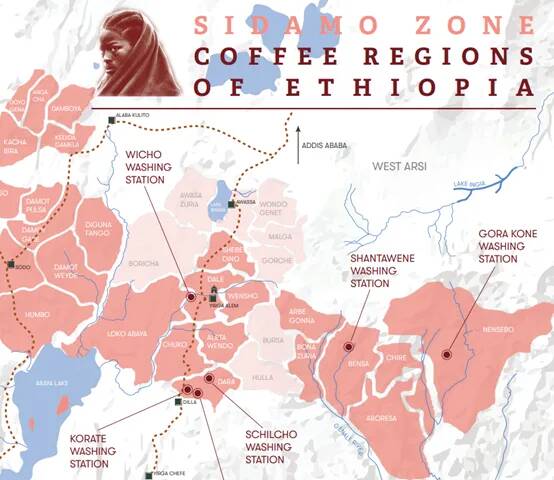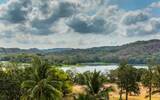Sidamo| Bensa coffee region
Ethiopia must be no stranger to coffee lovers. It is the largest Arabica coffee producer in Africa. Ethiopia has many producing areas, and in recent years, Sida Mobansa coffee beans have gradually come into people's view.
Sidama is the most award-winning region in COE, winning a total of 26 times. Among them, the winners are Arbegona, Bansha, Bura and so on. Bansha and Bura won the championship in 2020 and 2021. Distinctive floral aromas, bright fruit and a clean, long finish are their hallmarks.
COE in 2020 and 2021 was held in Ethiopia, while in the Sidamo producing area where COE made the list, there are mainly four towns: Arbegona, Bensa, Bura and Bona Zuria. The four towns are also geographically close, all located in the West Dharma Plateau. Of the five micro-producing areas listed by COE Sidamo in 2021, the champion farm is from the town of Bansha.

Ethiopia has a wide variety of coffee, divided by category, one is a traditional regional local variety, and the other is a digital coffee strain selected by the JARCJima Coffee Agricultural Experimental Center. The common regional varieties in Sidamo are: Dega, Wolisho, Kurume.
At COE in 2020 and 2021, the coffee varieties that represent West Dama are digital coffee from JARC. Among them, the COE champion coffee variety of West Damabra Town in 2020 is 74158, and the COE Champion Coffee Variety of West Mabansa Town in 2021 is 74165.

Bensa is located in the Sidamo region of southern Ethiopia, at an altitude of 1800-2300 meters. High altitude complicates the flavor of coffee, with typical, full-bodied fruit flavor and sometimes strawberry flavor available in Banza.
Bansha coffee beans in the treatment, washing, sun, red honey treatment are feasible. Among them, Bansha, which is washed with water, has a bright aroma and pleasant acidity. In the harvest season, the farmers will send the ripe coffee fruit to the treatment station, after screening and classification, remove the peel, ferment the pulp, then scrub it with clean water and put it on the drying bed for drying. It is worth noting that the first few days of the drying process need to be flipped every 2-3 hours. Depending on the weather, coffee beans need to dry for 12-15 days until the moisture in the beans drops to 11.5%.
Bansha is similar in pronunciation to a type of Guasha herbal tea in Guangdong, China, but it is not herbal tea. Banza coffee beans have a unique and delicate taste, mild and full-bodied, accompanied by fruity aromas, smooth taste and a long finish. These characteristics make Banza coffee beans popular among coffee lovers, and their unique flavor and high quality make them a variety worth tasting.
Important Notice :
前街咖啡 FrontStreet Coffee has moved to new addredd:
FrontStreet Coffee Address: 315,Donghua East Road,GuangZhou
Tel:020 38364473
- Prev

Panama predicts climate change! Reduced rainfall and rising temperatures will affect agricultural production
Recently, Panama's National Climate Change Adaptation Plan (NAP) proposed in a public statement on April 25 that due to the climate crisis, by 2050, rainfall in areas where Panama's largest Fili hydropower plant and agricultural land are located is expected to decrease by nearly 2.80%, directly affecting Panama's food security.
- Next

Sweet, sour, bitter, salty and fresh, will there be umami flavor in coffee? Why can't you taste the umami in your coffee? How to feel the taste of coffee?
Regarding describing the taste of food, sweet, sour, bitter, salty and fresh, our tongues all have different taste receptors to sense and identify them. But as far as coffee is concerned, people generally only describe it in terms of acidity, sweetness, bitterness, salty taste, etc. These four flavors are also the types of flavors that we can most easily taste and detect in coffee. with
Related
- What effect does Italian American coffee with filter paper have? Will coffee taste better if it is put on filter paper at the bottom of the powder bowl?
- What is the color difference in coffee beans? What are the characteristics of honey processed coffee beans? Why are the anaerobically treated coffee beans uneven in color?
- How does novice Xiaobai quickly get started and make coffee? Newbies learn to make coffee by hand and share the specific steps and process process!
- Costa tea has a shelf life of 100 years?! Expert: Unable to verify
- It's a huge uproar! American milk addition was rejected by Manner employees?!
- Mocha pot coffee bean recommendations| How fine and how much powder should be used for grinding? What parameter ratios do I need to use to make milk with Mocha pot coffee?
- What are the characteristics of the world's top ten coffee beans treated with Costa Rica honey? How to make black honey kadura from Tarazhu Pilon Processing Plant taste good?
- How to make deep-roasted coffee? What grinding water temperature does authentic Jamaica Blue Mountain No. 1 coffee use to brew it well?
- Selected high-grade rose summer coffee flavor tasting guide Why Panama rose summer has the aroma of flowers and fruits
- What equipment does a novice Xiaobai need to buy to learn to make coffee? Filter cup electronic scale bean grinder manual flushing pot purchase guide

